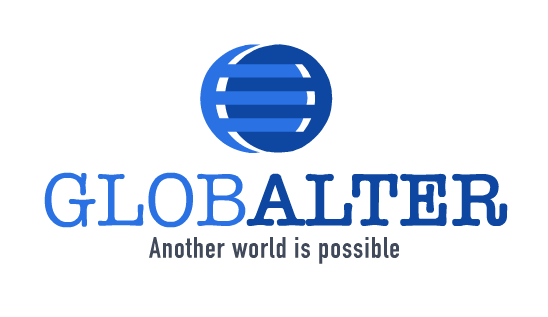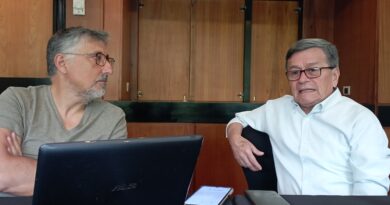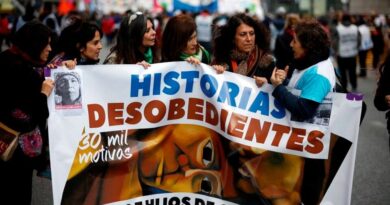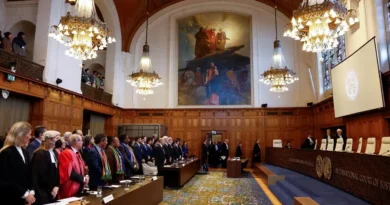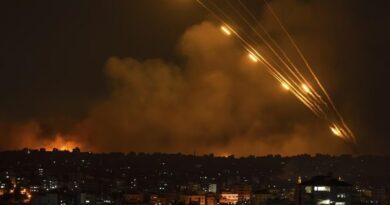An authoritarian escalation
NATASHA LENNARD
A single trash can lay prone at the intersection of West 139th Street and Amsterdam Avenue in Harlem, in front of the gates of the City College of New York.
Around 11pm on Tuesday, this was the extent of the damage I witnessed outside the university campus. At the same time, hundreds of New York Police Department officers, including members of the Strategic Response Group, a unit dedicated to public disturbances and “counterterrorism,” had gathered dressed in riot gear.
Less than an hour before, more police had burst in at the neo-Gothic gates of the center, at the request of the president of the university, to arrest the protesting students en masse.
Twenty blocks further south, police had closed and blocked all streets within a two-block radius of Columbia University, brutally detaining students within the inaccessible campus.
Between Columbia and City College, more than 200 protesters – almost all students – were arrested before the night was over.
It was a police response that reminded the repression that protesters received in the George Floyd riots of 2020. Almost four years ago, the police also responded with extraordinary violence to a massive protest. The alleged provocation then involved crucial acts of militant resistance, including low-level but widespread property damage, scattered looting, and the burning of several empty police vehicles.
Tuesday was different. In recent days, massive police operations have occurred on campuses in Manhattan and across the country in response to peaceful student encampments. Students gathered to share food, hold space for talks and rallies, and demand their universities divest from Israel.
At Columbia, student protesters occupied a university building: Hamilton Hall, the same building taken over by students in 1968 in protest of the Vietnam War. At most, during the last occupation of the building, some window panes were broken and some furniture was moved.
Petty property damage was, of course, not what was being monitored. Neither was the occupation of campus space; students have done it before in recent decades without their university administrators inviting militarized police force.
Instead, what was pursued was the protesters' message - condemnation of Israel and calls for a free Palestine - and the young people's commitment to it.
I have been reporting on political dissent and police violence for 15 years, especially in New York. Compared to Tuesday night, he had never witnessed at a protest site a use of police power so disproportionate to the type of demonstration taking place.
Make no mistake: This is an authoritarian escalation.
THE MYTH OF THE “EXTERNAL AGITATOR”
Campus repression offered a grim continuity: police and other officials used the same old excuses to quell resistance. In particular, his rhetoric relied on the predictable “outside agitator” fallacy.
New York Mayor Eric Adams used it to justify sending an army of baton-wielding police against the city's students. AND Deputy Police Commissioner Tarik Sheppard went even further on MSNBC on Wednesday morning, brandishing an inconspicuous chain lock—the kind I've seen on bicycles everywhere—as proof that “professionals,” and not the students themselves, had carried out the takeover of the school building. Columbia.
The bicycle lock business quickly became the subject of well-deserved ridicule, but the myth of the “external agitator” It's not a joke.
At the current moment, the “external agitators” evoked are both the eternal anarchist bogeymen and the Islamist terrorist groups that send funds to maintain student camps with the cheapest tents available on the Internet.
The “outside agitator” trope has a long racist legacy, including its use by the Ku Klux Klan. In the 1930s, the Ku Klux Klan posted flyers in Alabama in which he stated that “organizers in the pay of the communists are only trying to” get blacks “into trouble.” The claim does double rhetorical damage by denying the commitment of the organizers themselves and suggesting that “external” support from beyond a given place or institution is somehow a bad thing.
More recently, this argument has been put forward in defense of the repression of the movement in Atlanta, against the Stop Cop City protesters, that they had made a national appeal for reinforcements. And it was a common refrain for politicians across the country during the 2020 uprising, as well as the speech surrounding previous Black Lives Matter protests in Ferguson after police killed Mike Brown.
Blaming agitators or outside interests was always a propaganda ploy and remains so now. The idea that the Palestinian liberation struggle is a mere representation of Iranian interests repeats the delegitimizing logic of the past.
In fact, Gaza solidarity camps on campuses are organized and run by students, with Palestinian students front and center, and a disproportionately large presence of Jewish students as well. There are students, more than 1.000, who have faced arrests.
It is also the case that millions of people have called for an end to Israel's genocidal war, and support for Palestinian liberation is not and should not be limited to the mythical and maligned terrain of campus activism.
AUTHORITARY AMERICANISM
Police brutality and baseless excuses are nothing new, nor is bipartisan support for crackdowns.
What is new, however, is a most pernicious constellation: far-right attacks on education; police repression of white supremacy, which has been intensified and facilitated since 2020; a time when the United States clings to hegemony abroad; the Islamophobic and anti-Arab racism sanctioned in public since the war on terrorism; and, above all, a weakened left, at least at the electoral level.
These conditions create the backdrop for the only irrefutable excuse, a statement that brooks no argument and is ready to be manipulated and weaponized: the accusation of antisemitism.
Conscientious observers are all too aware of how this accusation is cynically used against anti-Zionist discourse and twisted to enable all manner of authoritarian abuses, including genocidal war.
It is no coincidence that this indefensible police repression is at the service of an indefensible war. The very extreme of the repression of the protests speaks of desperation on the part of the institutions of the American establishment.
Israel's destruction of Gaza has disproved - at least for millions of people - the redemptive myths of the post-World War II liberal political order. The young, even the children of the elite, even the children of Zionists, are with Palestine. Their peaceful acts of protest count as disruptive because they count as un-American, which should be a badge of honor in the midst of a US-backed genocide.
City College President Vince Boudreau, in his letter inviting the NYPD to storm the campus, placed particular emphasis on the fact that protesters had refused to take down a Palestinian flag from a flagpole.
After police cleared the campus of its students and filled the space with police, NYPD Deputy Commissioner Kaz Daughtry lowered the Palestinian flag and raised the American flag at full mast in its place.
Riot police cheered from below.
Natasha Lennard She is a writer and columnist for the American digital newspaper The Intercept. She has collaborated in newspapers such as The Nation and The New York Times. She is associate director of the Creative Editing and Critical Journalism program at the New School for Social Research in New York. Her latest book is: “Being Numerous: Essays on Non-Fascist Life.”
This article was originally published in English on The Intercept.
